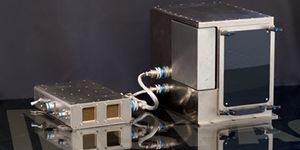
Pilots are trained to guard against vertigo: a sudden loss of the sense of vertical direction that renders them unable to tell up from down and sometimes even leads to crashes. Coming up out of a subway station can produce similar confusion, as for a few moments, you are unsure which way to go - until regaining your sense of direction. In both cases, the disorientation is thought to be caused by a temporary malfunction of a brain circuit that operates as a three-dimensional (3D) compass.
Weizmann Institute of Science researchers have now - for the first time - demonstrated the existence of such a 3D compass in the mammalian brain. The study was performed by graduate student Arseny Finkelstein in the laboratory of Prof. Nachum Ulanovsky of the Department of Neurobiology, together with Dr. Dori Derdikman, Dr. Alon Rubin, Jakob N. Foerster, and Dr. Liora Las. As reported in Nature on December 3, the researchers have shown that the brains of bats contain neurons that sense which way the bat's head is pointed and could, therefore, support the animal's navigation in 3D space.
Navigation relies on spatial memory: past experience of different locations. This memory is formed primarily in a deep-seated brain structure called the hippocampal formation. In mammals, three types of brain cells, located in different areas of the hippocampal formation, form key components of the navigation system: "place" and "grid" cells, which work like a GPS, allowing animals to keep track of their position; and "head-direction" cells, which respond whenever the animal's head points in a specific direction, acting like a compass. Much research has been conducted on place and grid cells, whose discoverers were awarded the 2014 Nobel Prize in Physiology or Medicine, but until recently, head-direction cells have been studied only in two-dimensional (2D) settings, in rats, and very little was known about the encoding of 3D head direction in the brain.
To study the functioning of head-direction cells in 3D, the Weizmann scientists developed a tracking apparatus that allowed them to video-monitor all the three angles of head rotation - in flight terminology, yaw, pitch, and roll - and to observe the movements of freely behaving Egyptian fruit bats. At the same time, the bats' neuronal activity was monitored via implanted microelectrodes. Recordings made with the help of these microelectrodes revealed that, in a specific sub-region of the hippocampal formation, neurons are tuned to a particular 3D angle of the head: certain neurons became activated only when the animal's head was pointed at that 3D angle.
The study also revealed, for the first time, how the brain computes a sense of the vertical direction, integrating it with the horizontal. It turns out that in the neural compass, these directions are computed separately, at different levels of complexity.
The scientists found that head-direction cells in one region of the hippocampal formation became activated in response to the bat's orientation relative to the horizontal surface - that is, facilitating the animal's orientation in two dimensions - whereas cells responding to the vertical component of the bat's movement - that is, a 3D orientation - were located in another region. The researchers believe that the 2D head-direction cells could serve for locomotion along surfaces, as happens in humans when driving a car, whereas the 3D cells could be important for complex maneuvers in space, such as climbing tree branches or, in the case of humans, moving through multi-story buildings or piloting an aircraft.
By further experimenting on inverted bats - those hanging head-down - the scientists were able to clarify how exactly the head-direction signals are computed in the bat brain. It turned out that these computations are performed in a way that can be described by an exceptionally efficient system of mathematical coordinates (the technical term is "toroidal"). Thanks to this computational approach used by their brains, the bats can efficiently orient themselves in space, whether they are moving head up or down.
This research supports the idea that head-direction cells in the hippocampal formation serve as a 3D neural compass. Though the study was conducted in bats, the scientists believe their findings should also apply to non-flying mammals, such as squirrels and monkeys that jump between tree branches, as well as humans. "Now this blueprint can be applied to other species that experience 3D in a more limited sense," Prof. May-Britt Moser, one of the 2014 Nobel laureates, writes in the News and Views opinion piece that accompanies the Weizmann study in Nature.
 Pilots are trained to guard against vertigo: a sudden loss of the sense of vertical direction that renders them unable to tell up from down and sometimes even leads to crashes. Coming up out of a subway station can produce similar confusion, as for a few moments, you are unsure which way to go - until regaining your sense of direction. In both cases, the disorientation is thought to be caused by a temporary malfunction of a brain circuit that operates as a three-dimensional (3D) compass.
Pilots are trained to guard against vertigo: a sudden loss of the sense of vertical direction that renders them unable to tell up from down and sometimes even leads to crashes. Coming up out of a subway station can produce similar confusion, as for a few moments, you are unsure which way to go - until regaining your sense of direction. In both cases, the disorientation is thought to be caused by a temporary malfunction of a brain circuit that operates as a three-dimensional (3D) compass.







